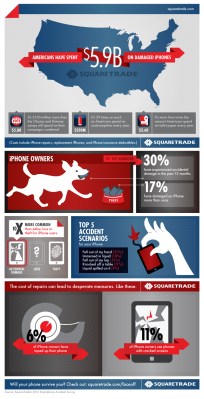SquareTrade, a company that provides warranty repairs for consumer electronics, revealed in a report today that Americans have spent an approximate cumulative total of $5.9 billion on damaged iPhones since the device’s introduction in 2007. That includes the cost of repairs, replacement iPhones, and insurance deductibles for plans like the warranties SquareTrade offers, and in large part, costs incurred are a result of accidental damage, more so than loss or theft.
The survey claims that just during the past year, more than 30 percent of iPhone owners have damaged their device, and repeat occurrences are fairly common: 17 percent have damaged their devices more than once. Younger iPhone owners tend to be the most accident-prone, according to the results, with one in two iPhone users 35 or under experiencing some kind of accident with their devices.
The major culprits when it comes to what events cause problems? Mostly drops from a decent height, via either just losing grip on the phone (30%), having it fall from someone’s lap (13%), or it getting knocked off a table (11%). Water damage is also a notable iPhone killer, via either complete immersion (18%) or having something spilled on it (9%).
SquareTrade put together the report using a survey of more than 2,000 iPhone owners, as well as market size data from comScore current as of May 2012. The company has access to a huge pool of damage data around consumer devices because of its trade as a warranty provider, but it’s also worth noting that that line of business means SquareTrade could be a bit biased in this matter. I’ll also point out that there’s no comparative data as to how the iPhone’s repair costs stack up against other devices, but it is an interesting snapshot of just how immensely popular the iPhone has been, and how even its service market alone represents a massive, multi-billion dollar industry.
Apple’s next iPhone makes its way to consumers and store shelves on Friday, and actually looks to be a little less susceptible to accidental damage than its predecessors, with a primarily aluminum back that should better handle drops without taking significant damage. It’ll be interesting to see if that has a significant effect on iPhone repair and service frequency and overall cost.
